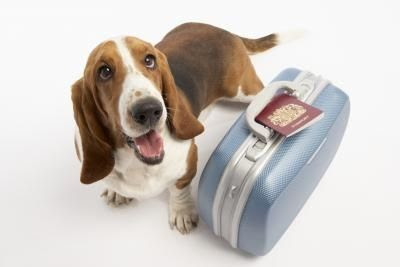The number of people who travel with their dogs is growing, and so too are the options for pets on the road. From "ruffing it" at campgrounds to enjoying fabulous four-star hotels, the time has never been better to pack up your pet and go.
Traveling with dogs offers some challenges, but nearly all are surmountable with common sense and creativity. Here’s what you need to know when you’re on the road.
Step 1: Talk With Your Vet
While most dogs come to enjoy riding in the car, many need help getting to that stage. Just like some people, some pets get motion sickness, while in others the problem is anxiety. Some dogs vomit when experiencing motion sickness. Other pets may drool excessively, with copious amounts of saliva drenching the upholstery, or pant uncontrollably. Some pets may do all of these.
Talk to your veterinarian about medications that can help address issues like anxiety and vomiting. For some pets – the anxious ones -- the medication may only be needed while your pet learns to become more comfortable in the car. For those pets with queasy tummies, anti-anxiety and anti-vomiting medication may always be needed when traveling. Your veterinarian can also advise you if medication is not the best option for your dog.
Step 2: Get Your Dog Acclimatized
Teach your dog to enjoy riding by using treats to reward tiny steps such as walking up to the car (treat), getting in (treat), getting into a harness or crate (treat) and then treats for progressively longer rides. Make sure during the learning period that the destination is somewhere she wants to go: A park, a pet-store or business where treats are handed out, or another place where your dog feels comfortable and happy, such as a friend’s house.
If your dog doesn’t seem to be getting more comfortable in the car, talk to your veterinarian about a referral to a veterinary behaviorist who can help.
Step 3: Get the Gear
While many of us remember our dogs riding shotgun, often with his head out the window, safety experts now advise that dogs be secured in the vehicle in a crate or harness. In an accident, a loose dog is a danger to herself, to others in the car and to everyone on the road. It is easy for one accident to turn into many if other drivers have to not only avoid your collision but also a terrified dog. Crates are probably the best means of safe restraint, but if you have a big dog and a small car, a crate likely isn’t an option. Fortunately, the last few years have seen many companies develop car-harness restraints that are not only comfortable for your dog but also work with your vehicle’s seat belts or child-seat anchors.
What about barriers? While these have long been popular in wagons, vans and SUVs, many barriers crumble or collapse under the forward impact of a dog in a crash. If you choose a barrier, be sure it can be secured to the car’s frame and is sturdy enough to hold up in an accident. If not, use a crate or a seat-belt harness.
Once restraint is under control, you’ll need to have food and water dishes and spill-proof containers for both. You’ll also need a leash and a comfortable travel harness or collar, and pick-up bags for cleaning up after your pet. A basic pet first-aid kit is recommended as well, and travel will be easier if you have a book of pet-friendly hotels or a tablet or smart phone app with these listings. Make sure you bring any medication your pet is on, along with what you need to give the pills, such as a pill gun or pill pockets.
And make sure your pet has an ID tag with your cell phone number on it. Even better: An ID tag and a microchip -- and make sure your pet’s chip is registered and the information is current.
4. Don’t Forget to Take Breaks
Walk your pet well before you hit the road to give her a chance to relieve herself. Once you’re en route, schedule potty breaks at least every few hours. Offer water at these breaks, and keep your pet’s feeding schedule as close to normal as possible. If your pet is on medication for nausea or anxiety, ask your veterinarian when to give the pills – with meals, on an empty stomach, an hour before you leave and so on.
Even if your dog knows to come when called in your own neighborhood, keep your pet on leash when traveling. Many pets get confused in new places and situations and may not be reliable off-leash, even where it’s allowed. And be responsible: Not only should you pick up after your pet but you should also prevent your pet from bothering others, whether by barking in a hotel room or running up to people who may not like dogs.
And most important: Remember that even on a day that’s merely “warm” the temperature in a car can reach dangerous levels within minutes – well over 100°F – even if the windows are partially opened.
Traveling with a dog has never been more popular, and never have there been so many products to help you and hotels to welcome you. Take advantage of dog-friendly America and you’ll both be happier.
All information in this post is from Vetstreet.









0 comments:
Post a Comment